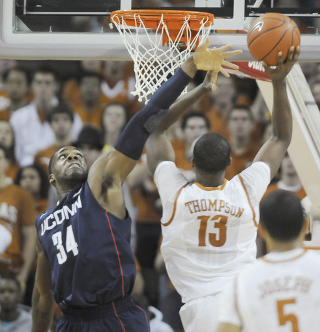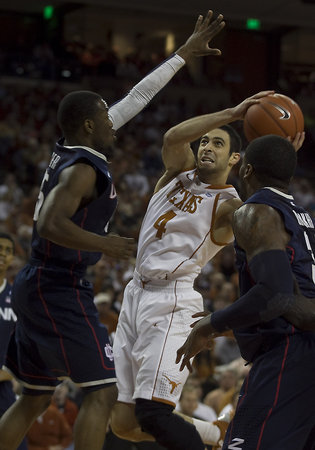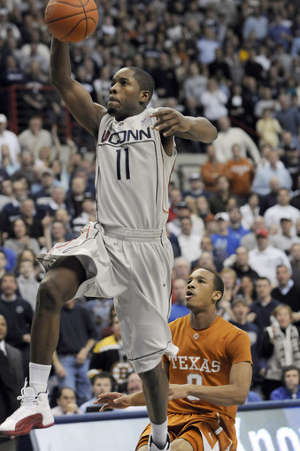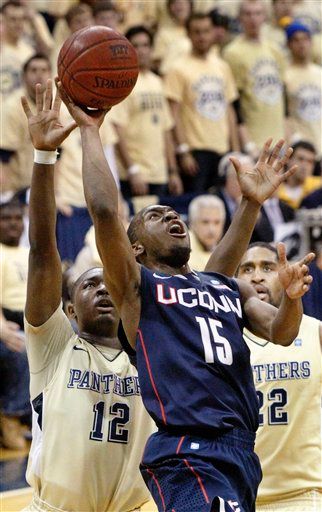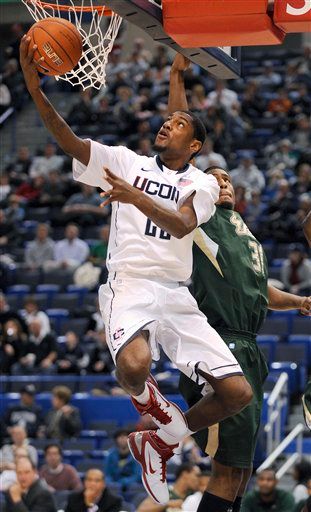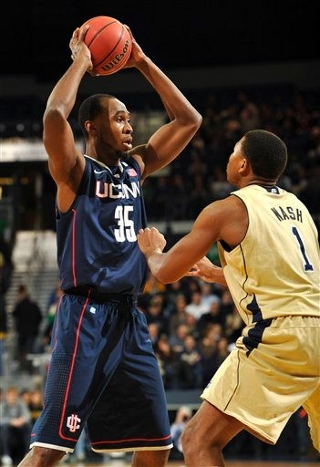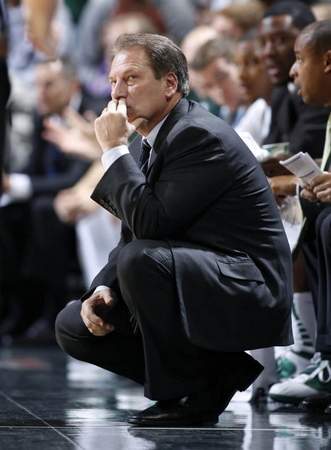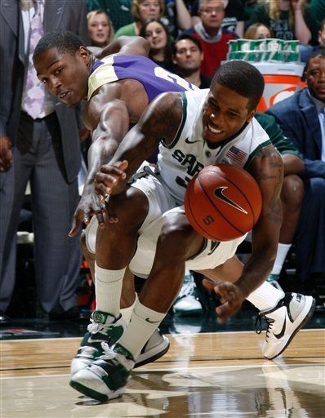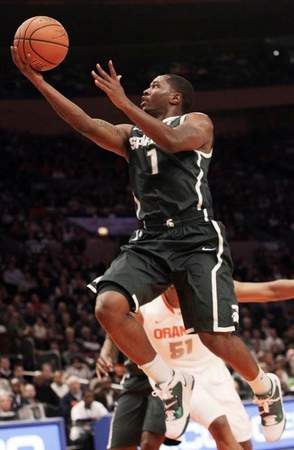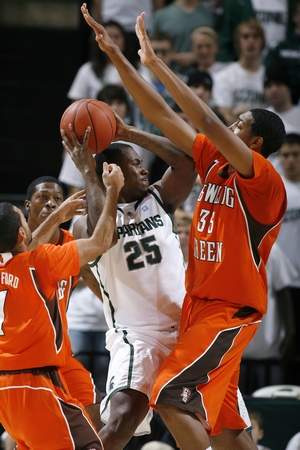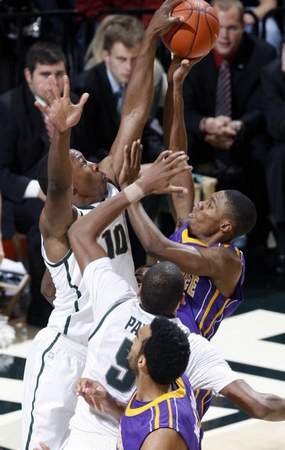With the Tech game less than 24 hours away, we’ll dispense with the introductions and get right into some post-game thoughts. 1) The game ball goes to Alex Oriakhi – Much has been written about Kemba Walker‘s performance in overtime, and there’s no denying that he single-handedly willed his team to victory in those extra five minutes. But without the sudden re-emergence of sophomore big man Alex Oriakhi, there’s no overtime for the Huskies to even play in.
Alex Oriakhi returned to his old form on Saturday Oriakhi looked like one of the nation’s most dominant bigs when he broke out at the Maui Invitational. In the three-game tournament, the sophomore tallied 45 points and grabbed 35 rebounds, logging double-doubles against both Michigan State and Kentucky. After re-entering the mainland, Oriakhi seemed to lose his mojo. He averaged just over eight points and six rebounds in the eight ensuing games, and saw his numbers dip even more in conference play thanks to foul trouble. Against the Longhorns, Oriakhi tore down an eye-popping 21 rebounds, including 11 on the offensive end. He chipped in 11 points, and came up with the biggest block of the night when he rejected Texas’ game-winning attempt with ten seconds left in regulation. If this is Alex Oriakhi that shows up the rest of this season, UConn will be a very tough team to beat. Without him, the Huskies are reduced to the Kemba Walker Show, and recent weeks have proven that he won’t be able to carry his team alone for much longer. 2) Free throws finally caught up with Texas – As a team, the Longhorns are currently the proud owners of a 64.8% free-throw mark. That’s good enough for 275th place in the country. To put it another way, there are only 70 teams in all of Division I basketball worse at the stripe than Texas. Against UConn, the Longhorns made just 14 of their 23 attempts. Big man Tristan Thompson was a frustrating 1-of-6 from the line, including two excruciating misses in overtime. Jordan Hamilton was just 1-of-3 when he headed to the stripe, with one of his misses coming on the front end of a one-and-one. It seems elementary to say that shooting 60.8% at the line cost a team the game when it was decided by just one point in overtime. But what is most frustrating about this never-ending free-throw nightmare is that while not only will it cost the Longhorns some wins against good teams, but it is likely also going to cost Texas a road game against a sub-par opponent. Losing an exciting, back-and-forth game to UConn is excusable. Losing in Lincoln or Norman? Not so much. 3) Damned if you Dogus, damned if you don’t – The Turkish Minister of Defense — better known by his given name of Dogus Balbay — is the biggest reason why Kemba Walker struggled so much on Saturday afternoon. It took 18 minutes for Walker to crack the scoreboard, and he finished regulation with just 15 points. Unfortunately, if you look at the substitution patterns late in the game, Balbay’s complete uselessness on offense essentially allowed the Huskies to force overtime.
Dogus Balbay struggled on the offensive end With the Longhorns down one and just under two minutes on the clock, Coach Barnes called a timeout and subbed in Cory Joseph for Balbay. The offense-for-defense maneuver worked, and Texas took the lead on J’Covan Brown’s jumper. As Balbay watched from the bench, Walker immediately attacked the rim, drawing a foul on a helping Thompson en route to a three-point play. There were a lot of moments in this game that all added up to a loss for the Longhorns. But Texas needs something, anything out of Balbay on the offensive end that will allow him to play more minutes. The team simply can’t afford to give an opponent’s best player an easier match-up in the most crucial minutes of the game. 4)Benchwarmers finally warmed up – J’Covan Brown had, without a doubt, his best game to-date on the 40 Acres. Sure, he still took a few questionable shots, but on Saturday afternoon, even two of those went in the bucket. He matched Jordan Hamilton with 20 points, despite playing 12 less minutes. From long range, a place he had struggled in mid-December, Brown was two for three. And on a day when nobody’s free throws seemed to go in, J’Covan made all four of his. While not as strong as Brown’s performance, Matt Hill‘s contributions were important. He struggled early, but bounced back to come up with some key defensive stops and snagged a few defensive rebounds when Texas couldn’t even buy one. He logged six total boards in the game, and actually posted the best defensive rebounding numbers on the team when adjusted for minutes. 5) If at first you don’t succeed, hope you’re playing Texas – Easy putbacks have been a thorn in the side of the Texas defense all season long. Against North Carolina, those second-chance points nearly cost the team a big victory. With the Huskies scoring 24 of their own second-chance points on Saturday afternoon — 17 of them in the second half — the Longhorns were lucky to claw back and force overtime. The worst part of the rebounding impotence is that it masked what was a quality defensive effort from the team. Texas held the Huskies to 38% shooting from the field, which is even more impressive when you consider how many shots UConn took just a foot or two from the bucket. The optimist will simply chalk this up as an aberration, a result of the Longhorns selling out in an effort to stop Walker. The pessimist will declare that this is the inevitable result of having a frontcourt with little experience beyond the starters. The answer may lie somewhere between the two extremes, but there’s no doubt that the upcoming battles in a rugged Big 12 Conference will settle the debate. The first big test for the Texas frontcourt arrives next Wednesday, when the Longhorns take on an A&M squad that is currently eighth-best in the nation on the offensive glass. Next up: at Texas Tech (8-8); 6 P.M., Tuesday |








